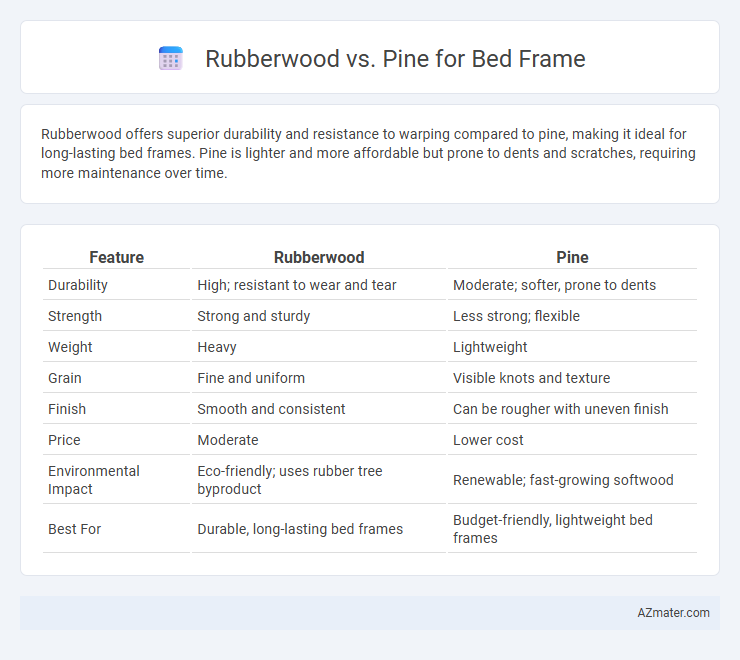Rubberwood offers superior durability and resistance to warping compared to pine, making it ideal for long-lasting bed frames. Pine is lighter and more affordable but prone to dents and scratches, requiring more maintenance over time.
Table of Comparison
| Feature | Rubberwood | Pine |
|---|---|---|
| Durability | High; resistant to wear and tear | Moderate; softer, prone to dents |
| Strength | Strong and sturdy | Less strong; flexible |
| Weight | Heavy | Lightweight |
| Grain | Fine and uniform | Visible knots and texture |
| Finish | Smooth and consistent | Can be rougher with uneven finish |
| Price | Moderate | Lower cost |
| Environmental Impact | Eco-friendly; uses rubber tree byproduct | Renewable; fast-growing softwood |
| Best For | Durable, long-lasting bed frames | Budget-friendly, lightweight bed frames |
Introduction to Rubberwood and Pine
Rubberwood, derived from the Para rubber tree (Hevea brasiliensis), is a sustainable hardwood known for its durability and resistance to warping, making it ideal for bed frames. Pine, a softwood from various species in the Pinus genus, offers lightweight construction with natural knots and a warm grain but is more prone to dents and scratches. Both woods vary in strength, aesthetic appeal, and environmental impact, influencing their suitability for different bedroom furniture styles.
Key Differences Between Rubberwood and Pine
Rubberwood is denser and more durable than pine, offering superior resistance to warping and cracking, which makes it ideal for long-lasting bed frames. Pine is lighter and softer, allowing easier customization and a more rustic aesthetic but may dent and scratch more easily. The eco-friendliness of rubberwood, sourced from plantation trees after latex extraction, contrasts with pine's faster growth cycle, influencing sustainability preferences.
Durability and Strength Comparison
Rubberwood offers superior durability and strength for bed frames due to its dense grain structure and resistance to warping and cracking under pressure. Pine, while lighter and more affordable, tends to be softer and more prone to dents and scratches, reducing its long-term sturdiness. Choosing rubberwood ensures a robust, long-lasting bed frame capable of withstanding daily use without compromising structural integrity.
Aesthetic Appeal and Grain Patterns
Rubberwood bed frames feature a uniform, light beige tone with subtle grain patterns that create a sleek, modern appearance ideal for minimalist decor. In contrast, pine offers a warm, golden hue with prominent knots and swirling grain, lending a rustic, natural charm to bedroom settings. The choice between rubberwood and pine depends on whether a clean, contemporary look or a cozy, country-style aesthetic is desired.
Environmental Impact and Sustainability
Rubberwood is a highly sustainable material as it is harvested from rubber trees that have exhausted latex production, effectively utilizing otherwise discarded timber and reducing deforestation. Pine, while widely available and fast-growing, often comes from plantations that may involve clear-cutting practices impacting biodiversity. Choosing rubberwood over pine for a bed frame supports eco-friendly forestry by promoting wood recycling and lowering the carbon footprint associated with timber harvesting.
Cost Effectiveness of Rubberwood vs Pine
Rubberwood offers a cost-effective alternative to pine for bed frames due to its lower price and sustainable sourcing from rubber plantations after latex extraction. Despite being more affordable, rubberwood maintains durability and resistance to warping, making it a practical choice for long-lasting furniture. Pine, while generally more expensive, provides a distinct grain and finish but may require additional treatments to enhance its durability, impacting overall cost-effectiveness.
Ease of Maintenance and Care
Rubberwood offers superior ease of maintenance for bed frames due to its high resistance to moisture and fungal decay, requiring only occasional dusting and mild cleaning solutions. Pine, while aesthetically pleasing, demands more frequent upkeep as it is prone to dents, scratches, and potential warping from humidity changes, often necessitating periodic refinishing or sealing. Choosing rubberwood reduces long-term maintenance efforts and helps retain the bed frame's structural integrity and appearance over time.
Suitability for Bed Frame Construction
Rubberwood is highly suitable for bed frame construction due to its durability, resistance to warping, and smooth finish that holds screws and joints well. Pine, while more affordable and lightweight, tends to be softer and more prone to dents and scratches, which may affect the bed frame's longevity and stability. Choosing rubberwood ensures a sturdier, long-lasting bed frame ideal for daily use and heavier weight support.
Pros and Cons of Rubberwood Bed Frames
Rubberwood bed frames offer excellent durability and eco-friendliness due to their sustainable sourcing from rubber trees after latex harvesting, making them resistant to warping and cracking. However, they tend to be heavier and may require proper finishing to prevent moisture absorption and potential insect damage. Compared to pine, rubberwood provides a denser, more stable structure, ideal for long-lasting furniture but at a slightly higher cost and maintenance level.
Pros and Cons of Pine Bed Frames
Pine bed frames offer affordability, lightweight construction, and easy customization, making them a popular choice for budget-conscious consumers. However, pine is softer than hardwoods like rubberwood, making it more prone to dents and scratches, and it may require regular maintenance to prevent warping or cracking. The natural knots and grain patterns in pine provide a rustic charm, but these characteristics can also contribute to structural weaknesses over time.

Infographic: Rubberwood vs Pine for Bed Frame
 azmater.com
azmater.com